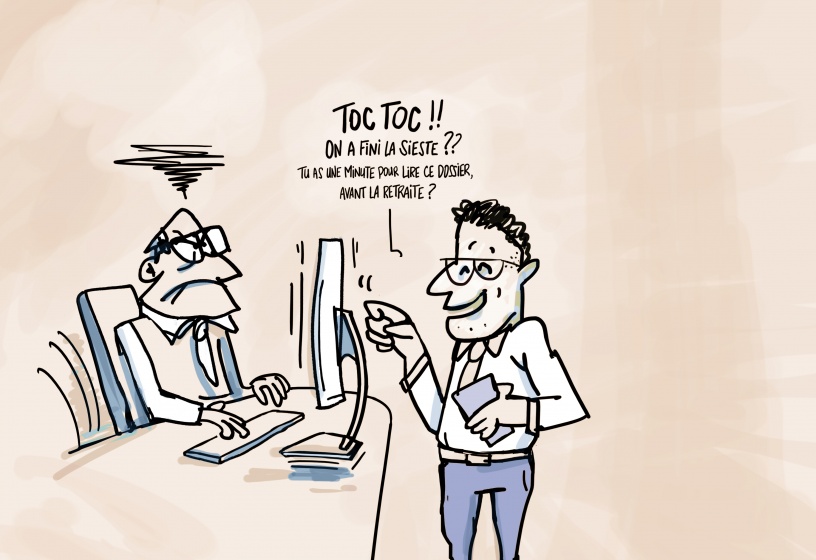Older Workers Facing Discrimination

Ageism is considered a global issue by the World Health Organization. According to a United Nations report, one in two people holds ageist attitudes. Stereotypes, biases and discrimination particularly affect older adults in the professional sphere, limiting their employment and advancement opportunities. These skewed perceptions negatively impact the workplace environment across all generations, including in Luxembourg.
Ageism refers to all forms of discrimination, exclusion, stigmatisation or contempt based on age, including exaggerated generalisations about the effects of ageing.
Older workers in the labour market: where does Luxembourg stand?
Ageism in the workplace is a complex phenomenon that manifests differently depending on context, sector and culture. One key indicator of senior inclusion is access to employment, especially as people aged 50 and over represent a growing share of the population. Across Europe, the differences are striking. According to Dares, 77% of people aged 55 to 64 are still active in Sweden, compared to only 44% in Romania. The European average stands at 62%.
In Luxembourg, the employment rate for those over 55 is significantly lower, at just 46.6% according to Statista. The country is among the four EU members where this rate falls below 50%, alongside Greece, Croatia and Romania. That said, the trend is improving; back in 2011, it was only 36%.
These national figures also reveal significant disparities, starting with a sharp gender gap. After age 55, a much higher proportion of women work part-time than men, which directly impacts their pensions. Access to jobs also differs depending on the sector.

Global campaign against ageism.
The sectors most likely to employ people aged 45 and over are construction, administrative services, and hospitality. STATEC data show that among Luxembourg residents, older workers are especially concentrated in public administration (28%) and hospitality (16%). In the category of farmers and skilled agricultural or forestry workers, 34.7% of active workers are aged 50 or over. Among those aged 65 to 84, there is also greater presence in commerce, real estate and specialised professions like law, architecture or research, where a more flexible work pace can enable extended activity.
It is important to note that these statistics only cover the resident population in Luxembourg. They do not include cross-border workers, who represent a significant — sometimes majority — share of the workforce in several sectors. Their experience of ageing at work remains largely undocumented.
The presence of older workers varies significantly from one industry to another. Beyond employment rates, cultural norms in different sectors can strongly influence the prevalence of ageism. In some industries, like finance or tech, ageism can set in surprisingly early. A global study by Data for Good found that in certain roles, people may start to feel excluded because of their age as early as their thirties.

Craft trades are Luxembourg’s largest employer, with 107,000 jobs in 2023. The sector spans all areas of socio-economic life, from consumer goods to industry subcontracting, construction, and the cultural sector. Today, 57% of its workforce comes from across the border, and 73% are men.
Over the next ten years, around one quarter of craft sector employees (between 23,000 and 26,000 people) are expected to retire. This demographic reality presents a major challenge in terms of passing on skills. The sector is looking to attract young talent capable of creating or taking over businesses. Workers over 50, with their experience, play a key role in this process by mentoring and training younger generations. Valuing senior workers is therefore essential and part of the broader fight against ageism.
Ageism: a hidden reality
In the workplace, ageism can be blatant or insidious. Refusing to hire, train or promote older employees, or forcing them into retirement, are discriminatory practices that are unlawful and should be condemned. However, ageism also thrives in more subtle, everyday forms: allowing jokes and sarcastic remarks about age, interrupting older colleagues, assuming older staff are resistant to change or to new technologies, questioning their professional competence or potential, or fostering a youth-centred culture.
According to Canada’s Centre for Occupational Health and Safety (Centre Patronal de Santé et Sécurité au Travail), ageism appears in four main forms, whether intentional or not. These are: hostile ageism (hurtful or malicious comments or actions), compassionate ageism (patronising or infantilising attitudes, often perceived as kindness), intergenerational ageism (discrimination between age groups), and intragenerational ageism (discrimination within the same age group).
Age-based discrimination remains a serious concern in the labour market. While it is widespread, it often goes unreported.
In Luxembourg, although complaints are rare, the Centre for Equal Treatment’s 2024 Discrimination Observatory ranks age as the fifth most common form of discrimination. According to the report, 46% of people who said they had experienced discrimination (of any kind) reported that it took place in a work context. Even more worrying, 59% said they are still affected by it, and one in four victims took no action at all.
Understanding and measuring ageism in the workplace
Luxembourg employers have much to gain from a clearer understanding of generational dynamics within their organisations. They can collect internal data — both quantitative (such as age distribution by department, seniority, or promotion rates) and qualitative (such as interviews or discussion groups on how age is perceived at work).
It is useful to carry out regular internal surveys to assess how ageism is perceived by both younger and older staff. Cross-referencing these results with indicators like employee engagement, satisfaction or mobility can help detect possible age-related bias. There are now tools available to map age and seniority in teams, analyse career progression by age group, or assess perceptions of ageism. In Luxembourg, the Diversity Charter offers a tool for conducting internal generational analysis by department, hierarchy level and gender. These approaches make it possible to move beyond assumptions and use a data-driven strategy to tackle ageism. This is all the more important given that, according to the OECD, age discrimination costs companies around 6% of their total payroll.
An individual, social and institutional responsibility
Ageism, in Luxembourg as elsewhere, will not disappear if it is treated as an isolated injustice. It is a deeply embedded social construct that shapes how we view ageing, people’s worth, and their role in professional life. It manifests in language, practices and systems, and affects people at every stage of life.
Fighting ageism does not mean proving that older people are still capable or energetic, because that implies age is a flaw that must be justified. A better and more powerful approach is to recognise that every phase of working life has its own value, strengths and challenges. It should be part of a broader reflection on how we understand time, career paths and how we value people throughout their lives. This means recognising age while refusing to let it define potential.
Career paths are still shaped by outdated, linear models that no longer reflect reality: reorientations, lifelong learning, breaks, career changes. Considering this complexity, we must approach ageism as a systemic issue, and question arbitrary categories such as "Is it even relevant to talk about senior workers?" or "Are we considered old at 45 or 50?"
Deconstructing ageism means rethinking the social and professional norms that sustain it, and acting at every level. On a personal level, everyone can challenge their own assumptions, cultivate open-mindedness and value experience in all its forms. This requires self-awareness and responsibility. At the organisational level, companies must promote inclusive practices, provide training, and foster a culture where age is neither a barrier nor a taboo. HR departments, managers and communicators all have a key role to play. Finally, on a structural level, governments, public institutions and social partners must strengthen legal protections to ensure equal opportunities. Associations and professional networks also have a key role to play as catalysts for change.
Tackling ageism means building a more equitable, human and sustainable work culture. It is a shared responsibility and a powerful opportunity to imagine a world of work where age does not divide us but enriches us.
Often confused with ageism, seniority refers to experience or length of service. While generally viewed positively for the expertise it brings, it can sometimes be misused to justify certain discriminatory practices.
To be read also in the dossier « Ageism in the workplace »



